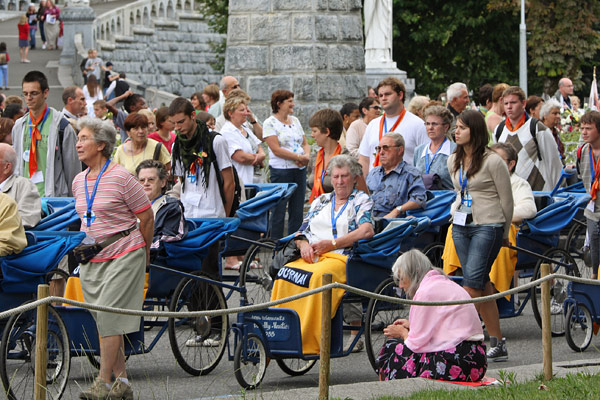Lourdes: 160 years of healing
In our modern day, the word ‘Lourdes’ often evokes imagery of the Virgin Mary’s apparitions, but the historical, geographical and social context is usually excluded from the imagination. What exactly is the history of the place where a young Bernadette Soubirous experienced the Marian visions and how did the area develop?
Before the year 1858, Lourdes was a sleepy market town known largely as a place where mountaineers on their way to Gavarnie stopped for supplies. It was situated at the foot of the Pyrenees, and is part of the Hautes-Pyrénées department in the Occitanie region in south-western France. The town was renowned for the Chateau fort de Lourdes, a fortified castle, which often provided protection against foreign forces throughout its history.
After the demolition of the parish of Saint Pierre in the 12th Century, it came to light that at the foot of the citadel stood an early pagan temple dedicated to the gods of water. This was replaced by an early Christian Church in the 5th Century which was later destroyed by a fire. The fortification that nowadays overlooks Lourdes was also developed by the Visigoths, Franks and Saracens. According to one legend the name Lourdes comes from the name of a Saracean leader who converted to Christianity and was given the name Lorus.
The Roman stronghold became the residence of the Counts of Bigorre in the 9th Century and was eventually given to England. However, in 1405, during the Hundred Years War, Charles VI eventually captured the town from the English. It was then sacked by the Hugenot troops during the religious wars of the 16th Century, and by 1607, Lourdes finally became part of the Kingdom of France. However, its emphasis as a military and state stronghold was overturned following the Marian apparitions, by which its spiritual history began.
Apparitions
In 1858, the young Bernadette Soubirous experienced 18 visions of a lady who introduced herself as the ‘Immaculate Conception’, soon to be identified as the Virgin Mary.
At the time of the apparitions, the naturally occurring grotto lay outside the town, on common ground which was used by the villagers for pasturing animals, collecting firewood, and as a rubbish tip. The lady always appeared in one place, in a small niche above the main cavity of the grotto. The terrain of the apparitions was not inconsequential, as the vision gave instructions to drink water from the spring that was close by, to build a chapel, and to have people come to the area in procession.
These instructions were instrumental in the subsequent development of the grotto.
The grotto and the land surrounding it was eventually purchased by a local priest, who immediately began modifying the area to make it suitable for visitors. The first of the churches also started be constructed which is now known as the Crypt.
In 1864, Joseph Hugues Fabisch was tasked to create a statue of Our Lady although he decided to conform to a more orthodox and traditional representation of the Virgin Mary, making her taller and older than what Bernadette had described.
In 1866, two years after the first local pilgrimage from Loubajac, France, a railway was built connecting Lourdes to the rest of the country and in 1874, the first international pilgrims arrived from Belgium.
Today, people come from around the world to pray at the sanctuaries and visit the important sites related to St Bernadette’s life and her 18 Marian apparitions. Many pilgrims also take home a bottle of water from the Massabielle grotto, where Mary showed St. Bernadette a dirty spring and asked her to drink from it.
Thirty-five water taps to the right of the spring enable pilgrims to drink the water. About 400,000 people annually immerse themselves in the water in the shrine baths and the seriously sick, in particular, wait in line for hours to reach the baths inside the chambers near the grotto. Others slide their fingers and run their hands along its damp walls smoothed by years of touching.
They also rub scarves, rosaries and written prayer attentions in the walls hoping that their prayers for Mary’s intervention will be heard, and that faith will be restored. A plaque above the 35 water spouts connected to the spring says: “Wash your face and ask God to purify your heart.”
The evening rosary procession, in which pilgrims hold candles, recite the rosary and sing ‘Ave Maria’ while slowly processing around the sanctuaries’ grounds, is a popular ritual at Lourdes. On the eve of February 11. at the feast of Our Lady of Lourdes and the World Day of the Sick, tens of thousands of pilgrims take part in the procession.
Although Mary did not specifically tell St. Bernadette in the apparitions to welcome the sick to Lourdes, the city has become a centre for those who seek healing. Many of the sick pilgrims stay at Accueil Notre-Dame, where they can be treated by a doctor.
The Sanctuaries of Our Lady of Lourdes are nestled tightly within the city. The churches are carved out of the Pyrenees Mountains, stacked above and below the grotto. Outside St Michael’s Gate – the pathway connecting the sanctuaries to the rest of the city – narrow, coalescing streets are filled with shops selling Catholic trinkets.
Intercession
The Catholic Church recognizes as miracles 67 cures attributed to Mary’s intercession at Lourdes. The first recognized miracle was of Catherine Latapie, 39, who prayed alongside Bernadette on March 1, 1858, while the series of apparitions was still in progress. She suffered from paralysis of her right hand, caused two years earlier by the fall from a tree, however, after washing her hand in the water, her fingers began to move.
Many of the apparitions have been compared to other visions of a similar nature. For example, only a few kilometres away from Lourdes, some shepherds guarding their flocks in the mountains observed a vision of a ray of light that guided them to the discovery of a statue of the Virgin Mary. Two attempts were made to remove the statue to a more prominent position but each time it disappeared and returned to its original location. A small chapel was built in light of this event.
Similarly, in the early 16th Century a young 12-year-old girl apparently received a vision of the Virgin Mary near the spring at Garaison.
In one word then, the history of Lourdes can be described as “transformation”, whereby a militaristic terrain became the place of a vision of peace.


 Colm Fitzpatrick
Colm Fitzpatrick Caregivers push pilgrims at the Shrine of Our Lady of Lourdes
Caregivers push pilgrims at the Shrine of Our Lady of Lourdes 